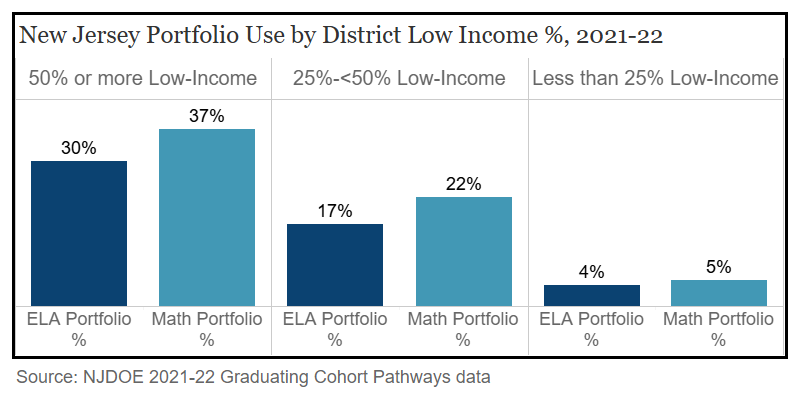Portfolio Appeals Put Enormous Burden on High Need Districts and Students

In 2022, 96,987 students graduated from New Jersey high schools. Each one had to satisfy the state’s “exit testing” requirement since New Jersey is one of the few states that requires students to pass a graduation assessment to receive a diploma, even if they have completed all their credit, attendance, and other requirements.
Students have multiple “pathways” to satisfy the requirement. In 2022, about half of all graduates did so by passing the NJ Student Learning Assessments (NJSLA). Another third, used a substitute assessment such as the SAT or ACT.
But 10-15% of 2022 graduates, about 16,400 students – including students who struggle the most with standardized tests – had to use the time-consuming and often confusing “portfolio appeals” process. Twelve percent of that graduating class used the portfolio process to satisfy the English language arts (ELA) requirement, and fifteen percent used it for math.
But while the NJ Department of Education (NJDOE) reports the overall number of students who complete “portfolio appeals” each year, the disportionate burden the process puts on the state’s high need districts and most vulnerable students has received little attention.
The portfolio process requires ongoing investments of resources and staff time that go well beyond the familiar and disruptive multi-day testing schedule most districts and schools endure during state testing periods.
For example, standardized tests like the NJSLA and the SAT are prepared and scored by testing vendors. But the portfolio process requires each district to create “Constructed Response Tasks” (CRT) according to detailed state rules. (See these portfolio FAQs for ELA and Math.) District staff must provide supplemental instruction with practice CRTs and fill out detailed forms for each portfolio appeal student. Staff must also review and score each CRT, again according to detailed rubrics supplied by Pearson, Inc., the multinational testing company. A completed portfolio appeal includes four graded CRTs for each subject and an “Educational Proficiency Plan” that includes each student’s academic and testing history. The graded CRTs must be sent to the NJDOE for review and approval.
Districts with high percentages of English learners face special challenges. For example, students who are not native English speakers may be assessed in their native language, but the process is onerous and potentially expensive for districts. To administer portfolio CRTs in a student’s native language, districts must:
- Write the CRT in English;
- Have the CRT translated into the student’s native language, using a district-selected process for translation services;
- Translate the student response into English;
- Complete all the steps described above and send submissions to the NJDOE’s Office of Assessments.

Portfolio Appeals Students Face the Most Testing
Portfolio students take the most tests. To submit a portfolio appeal, students must first take the annual New Jersey state tests. If they don’t pass those tests, most districts require that before submitting a portfolio, students take one or more “substitute” tests. If they reach senior year still needing to complete a graduation assessment, many districts require such students to give up an elective to take a portfolio preparation course or sign up for portfolio instruction before or after school or on weekends. The time-consuming process must begin early in the senior year and stay on track throughout the NJDOE’s six-month window for portfolio submissions in order to be sure of approval before graduation in June.
“The portfolio process puts tremendous pressure on students throughout senior year when they should be concentrating on planning for the future and enjoying one of life’s major transitions,” said Stan Karp, Director of Education Law Center’s Secondary Reform Project. “It requires tremendous time and investment from districts and students for an assessment that has no instructional value and comes far too late to have any useful impact on a student’s educational career.”
Portfolio Appeals Burden Falls Heaviest on High Need Districts and Students
Districts with more low-income students, more Black and/or Hispanic students, and more English learners are much more likely to rely on portfolios to help their students fulfill graduation requirements. For example, 30% of students who were in districts with 50% or more low-income students fulfilled the graduation requirement for ELA with portfolios, compared to just 4% in districts with less than 25% low-income students. Half of all students in districts with 20% or more English learners fulfilled the graduation requirement for math by portfolio use, compared to only 10% in districts with less than 10% English learners. And 40% of students in districts that are 80% or more Black and/or Hispanic used the math portfolio for graduation, compared to just 5-6% using a math portfolio for graduation in districts with white majority composition.


“The portfolio process is another broken part of New Jersey’s exit testing system,” Mr. Karp added. “It has no educational value and mostly exists as a safety valve to prevent a graduation meltdown that would deny diplomas to thousands of students who have stayed in school and completed all their credit and other requirements. In recent years, more than a dozen states have repealed their exit testing policies. It’s long past time for New Jersey to do the same.”
A bill to eliminate exit testing for high school graduation (A4639/S3308) passed the State Assembly in June with a vote of 64-9, but the bill has so far not moved in the State Senate.
Related Story:
EXIT TESTING IS LOWERING NJ’S GRADUATION RATE
Press Contact:
Sharon Krengel
Director of Policy, Strategic Partnerships and Communications
skrengel@edlawcenter.org
973-624-1815, x240